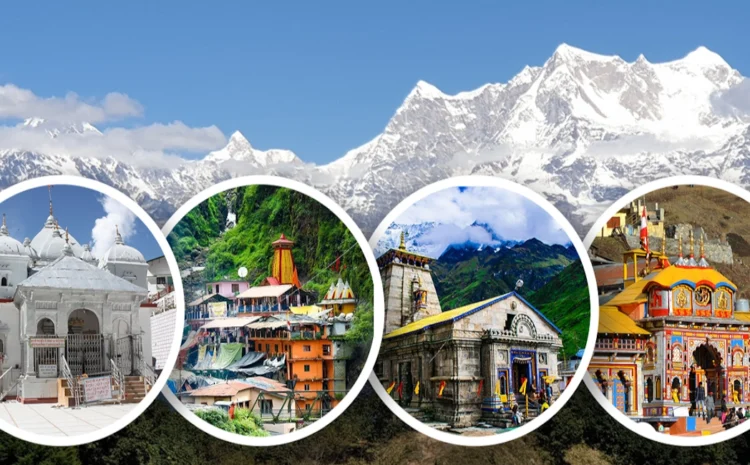
Char Dham Yatra: A Journey of Spiritual Enlightenment
The Char Dham Yatra, one of the most revered pilgrimages in India, draws millions of devotees every year to the sacred sites nestled in the Garhwal region of Uttarakhand. This pilgrimage, which spans the high Himalayan ranges, covers four holy shrines: Yamunotri, Gangotri, Kedarnath, and Badrinath. The journey holds deep spiritual significance for Hindus, with each of these destinations representing an important aspect of the divine.
Spiritual Significance of Char Dham
The word “Char Dham” means “four abodes” or “four seats” of the divine. According to Hindu tradition, undertaking this pilgrimage washes away sins, leads to spiritual liberation (moksha), and brings one closer to divine consciousness. Each of the four destinations is associated with different gods and natural elements, highlighting the interplay between spirituality and nature.
- Yamunotri is dedicated to Goddess Yamuna, the sacred river that originates from the glaciers of the Himalayas. The Yamuna is believed to be the sister of Yama, the god of death. Bathing in its waters is said to absolve devotees of their sins and protect them from untimely death.
- Gangotri is the origin of the Ganges, considered the holiest river in Hinduism. The temple at Gangotri is dedicated to Goddess Ganga, and the river here is believed to have descended from heaven to cleanse humanity of its sins. Devotees visit Gangotri to pay homage to the river and to experience its spiritual and purifying power.
- Kedarnath is one of the 12 Jyotirlingas dedicated to Lord Shiva. Situated at an altitude of 3,583 meters, it is the highest among the four sites. Shiva, revered as the destroyer and transformer within the Hindu Trinity, is worshiped here as Kedarnath, a manifestation associated with liberation and spiritual growth. The temple’s remote location and dramatic mountain backdrop make it a challenging but deeply rewarding part of the journey.
- Badrinath is dedicated to Lord Vishnu, the preserver and protector in Hinduism. The Badrinath Temple, situated along the banks of the Alaknanda River, is one of the most revered Vaishnavite sites in India. It is believed that visiting Badrinath allows devotees to connect with the divine aspect of preservation and receive blessings for well-being and prosperity.
Historical and Mythological Background
The Char Dham Yatra has roots in ancient mythology and has been a part of Hindu culture for centuries. According to Hindu scriptures, the Pandavas from the Mahabharata are said to have undertaken this pilgrimage to seek forgiveness for their sins after the Kurukshetra war. The pilgrimage is also mentioned in various Puranas and is said to be a path that leads to moksha.
The present-day temples, however, were constructed much later. Adi Shankaracharya, an 8th-century Indian philosopher and theologian, is credited with establishing the Char Dham as a single pilgrimage circuit. His mission was to unify Hinduism and encourage spiritual practice by connecting devotees to these important holy sites across India.
The Journey: Route and Challenges
The Char Dham Yatra typically begins from Haridwar or Rishikesh, two major spiritual centers in Uttarakhand. From there, pilgrims proceed to Yamunotri, Gangotri, Kedarnath, and finally Badrinath. The entire journey covers a distance of over 1,600 kilometers through winding mountain roads, steep ascents, and river crossings. Due to its difficult terrain and high altitude, the Char Dham Yatra requires a certain level of physical and mental endurance, making it as much a test of faith as a spiritual retreat.
The journey is undertaken mainly from April to November, with the best time being May to June and September to October, avoiding the heavy monsoon rains that make the roads treacherous. The Yatra typically begins with a visit to Yamunotri, followed by Gangotri, and then Kedarnath, and ends at Badrinath. Helicopter services, pony rides, and porters are available at various points along the route to assist pilgrims who may find the trek physically challenging.
Despite the rigors of the journey, pilgrims are drawn to the Yatra because of the belief that visiting these sacred shrines will bring blessings, peace, and fulfillment. Along the way, pilgrims experience not only the spiritual energy of the temples but also the breathtaking beauty of the Himalayas.
Modernization and Facilities
In recent years, the Char Dham Yatra has become more accessible, thanks to improved road networks, accommodations, and the availability of helicopter services to reach the more remote sites like Kedarnath. The Indian government has invested in better infrastructure, which has made the pilgrimage more comfortable for elderly devotees and those with limited mobility.
Rest houses, guesthouses, and dharamshalas are available throughout the pilgrimage route, offering basic but comfortable accommodation for the pilgrims. Many temples along the route also provide free meals (langar) to the devotees. Additionally, medical facilities and emergency services have been strengthened to ensure the safety of pilgrims during the journey.
Spiritual Experience
The Char Dham Yatra is not just a journey through the majestic landscapes of the Himalayas but also a spiritual sojourn. Pilgrims believe that by visiting these four holy abodes, they will be blessed with divine grace, spiritual enlightenment, and a deeper connection with their faith. The transformative power of the Yatra lies in the devotion and perseverance it requires, reminding pilgrims of the path to salvation through dedication, service, and surrender to the divine.
In conclusion, the Char Dham Yatra is a pilgrimage like no other—one that combines physical endurance, spiritual growth, and an encounter with the natural beauty of the Himalayas. For devotees of Hinduism, it is a journey that brings them closer to the divine and deepens their spiritual practice, leaving an indelible mark on their souls.
